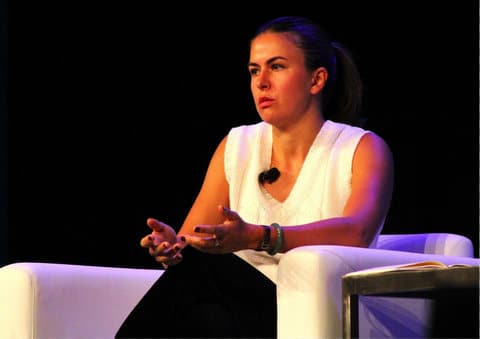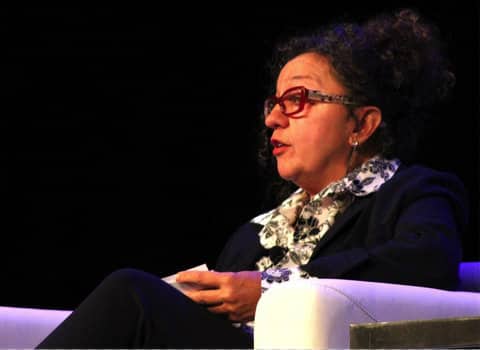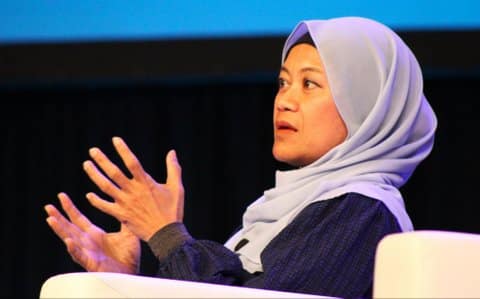
17 Mar ‘Closer and Closer to Losing Him Forever’: Hate Groups Prey on Young Men, Tear Families Apart

Emily Oneschuk spoke at the Eradicate Hate Global Summit about how her younger brother, Andrew, became an extremist before being killed by a fellow hate group member. (Joe Porrello / The CC Pulse)
Editor’s note: The Eradicate Hate Global Summit began in 2021 in response to the mass shooting at the Tree of Life synagogue. Last year, The CC Pulse was there for the first time in service of our Stop the Hate coverage. This is one of many stories we will publish that is about or inspired by the summit.
By Joe Porello
PITTSBURGH — Early one morning, energetic music blared as a video showed men in masks and fatigues loading and firing guns and setting fire to flags for Black Lives Matter, Israel, LGBTQ+ pride and even the “Thin Blue Line” and “Don’t Tread on Me” flags.
It was a recruitment video for the Atomwaffen Division, a terrorist neo-Nazi organization. The people watching were at the Eradicate Hate Global Summit, trying to learn how such groups operate in an effort to stop them.
The New York Times labeled the group among the most violent of far-right extremists.
At 17, Atomwaffen member Nicholas Giampa allegedly killed his girlfriend’s parents. Twenty-year-old Samuel Woodward was accused of killing his former classmate — stabbed more than 20 times — because he was gay and Jewish.
Filmmaker Jessica Cran, who created a documentary series about groups like Atomwaffen, said it believes society and politics are inherently impractical, corrupt and irredeemable — ultimately heading toward collapse and a battle for supremacy.
“White supremacist activity is considered by many to be the greatest threat to both our democracy and to national security,” she said.
Cran said technology helps hate groups, citing misinformation, alienation and radicalization.
“When a culture struggles to keep pace with the rapid and seismic shifts the (internet) brings, it can birth unintended social consequences,” she said. “Anyone can get caught up in this vortex of hate.”
Cran said online games are often wrongly considered innocuous by parents.
“It’s on sites like these that vulnerable kids…are groomed, recruited and gradually steeped in violent tribalism,” she said.
>>>Read: Hate Speech and Extremism Recruitment Rising in Video Games but Maybe Not For Long
Youth membership is swelling in hate groups.
“Their target audience is misguided and disenfranchised young men, who they aim to draw into their terroristic fold by appealing to their fantasies of being a strongman, a hero or a rebel with a cause,” Cran said.
What links — but does not implicate — many extremists, according to Cran, is depression, anxiety, childhood trauma, learning difficulties, autism and looking for acceptance or a place to call home — “none of which can predict violent fundamentalist behavior, but all of which mark them as different from their peers, set them apart from the modern world, and make them vulnerable to hateful messaging.”
Messaging like the video shown at the summit.
“They’ll bombard them with shocking visuals and violent motifs until they’re numb and immune,” Cran said. “They will offer solace, camaraderie and raison d’etre to fill the void of these boys’ sometimes lonely and often directionless lives.”
>>>Q&A: How Youth Become Radicalized and What to Do
One such person was Devon Arthurs, an early AWD recruit who at the age of 18 killed two of his roommates, including 18-year-old Andrew Oneschuk.
Andrew’s sister, Emily, said her brother’s descent into extremism was unexpected.
“Things were pretty normal growing up. I’d say we lived an idyllic life,” said Oneschuk. “I was very lucky to have two devoted parents, lots of extended family, and many opportunities.”
She said things began to change when their father was deployed overseas for a year when Andrew was 11.
Around this time, he began using racial slurs she had never heard.
Oneschuk says she and their mother did not know what to do. “No punishment worked.”
“Many are quick to point the finger at the parents of boys like these,” Cran said, “with accusations like, ‘It all starts with the family,’ but… it’s incredibly difficult to deflect a loved one from the path of fundamentalism.”
Oneschuk said Andrew would watch AWD recruitment videos before bed.
“When you’re curious and unguided, the internet can bring you to some dark places… that’s my hypothesis on how he got into this,” Oneschuk said.
>>>Read: As Tech Turns to A.I. to Fight Hate, Experts Warn Human Input Is Critical
She says her family lived with the slow creep of Andrew’s radicalization for seven years.
“It pretty much tore us apart,” Oneschuk said. “I felt like I was losing my brother more and more every day to something dark and angry that I couldn’t explain.”
She sometimes wanted to give up on Andrew but, as his sister, could not abandon him.
Feeling like she had made progress, Oneschuk once came home to find a swastika flag on Andrew’s bedroom door. She tried ripping the flag in half, which prompted what she said was the only physical altercation they ever had.
“I felt like I had to apologize because he said, ‘You don’t respect my beliefs. You don’t understand me,’ and it was this confusing mix of every emotion you could imagine,” Oneschuk said. “As much anger and frustration as that flag represented, me doing that really pushed him further away from me. Any time I argued, I wasn’t getting any closer to solving the problem, I was just getting closer and closer to losing him forever.”
Before Andrew left for what his family thought was college in Florida years later, he apologized to his parents and told his sister he wanted to join the Navy.
“I began to feel like I had a brother again,” Oneschuk said.
Instead, Andrew went to Florida to live with other AWD members.
According to Cran, they transformed their apartment into a pit of Nazi memorabilia, fundamentalist literature — like Hitler’s “Mein Kampf” — and AK-47s. AWD leader Brandon Russell used his degree in nuclear physics to make homemade bombs. (Atomwaffen in German means nuclear, or atomic, weapons.)
“This was not a college hangout,” Oneschuk said. “This was a neo-Nazi cell.”
She said her family was completely caught off guard when they got the call Andrew had been shot.
According to CBS News, Arthurs killed the two because they ridiculed his conversion to Islam. He pleaded guilty last year, was sentenced to 45 years in prison and will be eligible for parole after 25, followed by 15 years of probation.
Russell served five years in prison for the bombs found at their home. Last year, he was arrested on suspicion of plotting to blow up the power grid in Baltimore. The trial is set to begin July 8.
Oneschuk says journalists still ask her to identify her brother in photos, videos or recordings.
“One was a video of him putting up posters around a college campus saying, ‘Join your local Nazis,’ Oneschuk said. “It had been three years since his death, and everything came rushing back.”
She was frustrated nobody took the problem seriously before Andrew was killed.
One FBI agent told her it was probably just a phase and that they could not do anything unless there was intent of violence. Her brother’s psychologist said he had defiance disorder — nothing major.
Even after Andrew’s death, she said FBI reiterated “these boys usually grow out of it when they get girlfriends,” which she called “a real kick in the gut.” The FBI has since labeled Russell a domestic terrorist.
Oneschuk said she is proud of how the rhetoric around extremism has changed. That has partly come as the media has brought it more into the forefront.
But that has put journalists in extremists’ crosshairs.
Atomwaffen put threatening letters and posters with intimidating visuals — like a person with a gun to their head — on the windows or in the mailboxes of journalists’ homes. According to investigative reporter Chris Ingalls, some posters had “Death to Pigs” written in blood on them, a tribute to Charles Manson. “This caused intense terror.”
He said threats were made during the pandemic when people were supposed to stay in, yet reporters could not feel safe in their own homes.
That was the case for Ingalls and his family.
Working at local NBC affiliate KING 5, Ingalls exposed AWD operations in Seattle.
Ingalls found a letter in his mailbox covered in swastikas that said, “You’ve been visited by your local Nazis,” which he brought to the FBI.
“I was told that trouble could be coming right to my doorstep,” he said. “We didn’t waste any time. We had the kids pack their bare essentials into a bag and throw it into the trunk of the car, and we went and stayed in a hotel for several nights.”
In a segment in which he interviewed her on air, Ingalls’ wife said, “I just wanted to grab the kids and take them home, and then I realized home is the one place we shouldn’t be.”
Thomas Woods, an assistant U.S. attorney, said Atomwaffen tries to scare journalists to silence them.
“One poster said, ‘Actions have consequences. Be quiet’… Atomwaffen’s efforts were a failure,” said Woods. “The heroes of unmasking Atomwaffen were really the journalists.”
>>>Read: Ethnic Media Spreads the Word to Help Stop the Hate
Oneschuk has spent years dealing with her grief and trying to figure out how extremist groups like AWD can be curbed.
“It takes many people coming together,” she said, “thinking creatively and bringing people together who think very differently and don’t agree with each other on everything.”
Oneschuk, who exchanged letters with Russell while he was in prison, also says empathy is important.
“I needed them to be people and not monsters,” Oneschuk said. “The more we make this about us versus them, the further we get away from solving the problem.”
Atomwaffen disbanded after arrests in 2019 and 2020 decimated its membership, according to the ADL. But a new group called the National Socialist Order emerged under the remaining leadership.
This resource is supported in whole or in part by funding provided by the State of California, administered by the California State Library in partnership with the California Department of Social Services and the California Commission on Asian and Pacific Islander American Affairs as part of the Stop the Hate program. To report a hate incident or hate crime and get support, go to CA vs Hate.





No Comments